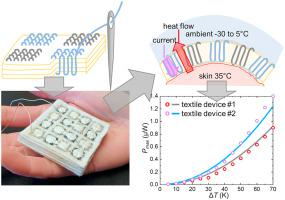Journal of Power Sources ( IF 8.1 ) Pub Date : 2020-09-09 , DOI: 10.1016/j.jpowsour.2020.228836 Anja Lund , Yuan Tian , Sozan Darabi , Christian Müller

|
Conducting polymers offer new opportunities to design soft, conformable and light-weight thermoelectric textile generators that can be unobtrusively integrated into garments or upholstery. Using the widely available conducting polymer:polyelectrolyte complex poly(3,4-ethylenedioxythiophene):poly(styrene sulfonate) (PEDOT:PSS) as the p-type material, we have prepared an electrically conducting sewing thread, which we then embroidered into thick wool fabrics to form out-of-plane thermoelectric textile generators. The influence of device design is discussed in detail, and we show that the performance of e-textile devices can be accurately predicted and optimized using modeling developed for conventional thermoelectric systems, provided that the electrical and thermal contact resistances are included in the model. Finally, we demonstrate a thermoelectric textile device that can generate a, for polymer-based devices, unprecedented power of 1.2 μW at a temperature gradient ΔT of 65 K, and over 0.2 μW at a more modest ΔT of 30 K.
中文翻译:

聚合物基纺织热电发电机,用于可穿戴式能量收集
导电聚合物为设计柔软,舒适,轻便的热电纺织发电机提供了新的机会,这些发电机可以毫不干扰地集成到服装或室内装潢中。使用广泛使用的导电聚合物:聚电解质复合物聚(3,4-乙撑二氧噻吩):聚苯乙烯磺酸盐(PEDOT:PSS)作为p型材料,我们制备了导电缝纫线,然后将其绣制为粗线羊毛织物形成面外热电纺织品发生器。详细讨论了设备设计的影响,并且我们证明,只要模型中包括电气和热接触电阻,就可以使用为常规热电系统开发的模型来准确预测和优化电子纺织设备的性能。最后,T为65 K,并且在更适度的ΔT为30 K时超过0.2μW 。











































 京公网安备 11010802027423号
京公网安备 11010802027423号